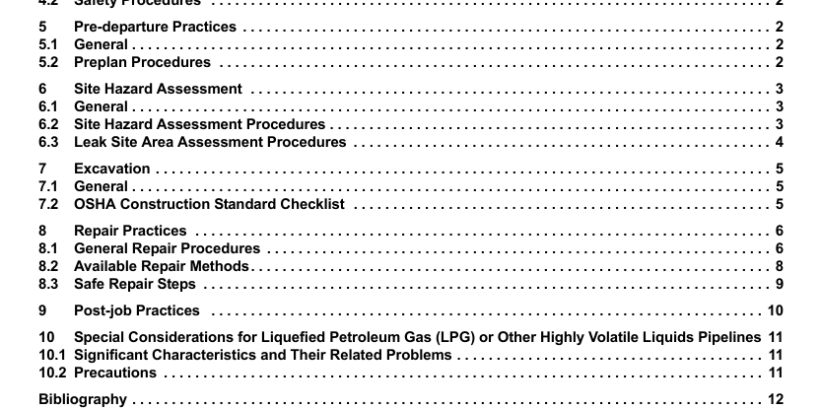API RP 2200:2015 pdf free download.Repairing Hazardous Liquid Pipelines
4 Preliminary Knowledge
4.1 Personnel Qualified oversight is a prerequisite to the successful implementation of pipeline repair practices. Regulatory requirements for the qualification of pipeline personnel performing repair activities are covered in DOT Regulation 49 CFR 195.501 through 195.509 of Subpart G (Operations and Maintenance). Guidance for the development and implementation of operator qualification (OQ) programs and procedures are given in ASME B31Q, Pipeline Personnel Qualification, and in API 1161, Guidance Document for the Qualification of Liquid Pipeline Personnel. Personnel working on pipeline repairs must understand the importance of careful planning to ensure safe and efficient practices and procedures. Employees and contractors should be briefed onite about specific repairs and safety procedures. Only personnel with the proper training, experience and demonstrated skills should be allowed to perform pipeline repairs.
4.2 Safety Procedures Repair personnel shall have a basic knowledge of safety procedures that includes, but is not limited to, lockout/tagout (LOTO); confined space; worker’s right-to-know; personal protective equipment; excavation and trenching; fire prevention and protection; emergency response; atmospheric testing devices; hot work; work permitting; respiratory protection; hydrogen sulfide; hearing conservation; first aid; hazardous substances; fall protection; ergonomics; electrical hazards; and abrasive blasting; Regulations to protect worker safety are covered in OSHA 29 CFR 1910 (operations) and 29 CFR 1926 (construction).
The company person or designee with overall responsibility for the repair should review previous testing and repair files to determine the presence or absence of asbestos-containing pipe coatings, lead-based paint, or other substances requiring special attention. If coatings are identified to contain hazardous substances, special work practices designed by the company’s health and safety department to mitigate employee exposure should be used. Additional handling and disposal requirements may be specified by local, state, or federal agencies, consult regulations in your area to determine and develop appropriate handling procedures. In addition, the company person or designee with overall responsibility for the repair should be knowledgeable about the most recent Department of Transportation Alert Notices and National Transportation Safety Board recommendations related to pipelines as they may pertain to the specific repair situation. 5 Pre-departure Practices
5.1 General When piping revisions, replacements, or repairs are needed, the goal is to safely and efficiently complete the work. Work shall include in-service and out of service repairs. To ensure the safe and efficient completion of the repair project, the proper preplanning and groundwork shall be accomplished before any work is done.
5.2 Preplan Procedures The preplan should include the following steps.
a) Consult and comply with all applicable laws and regulations.
b) Notify “ONE CALL” service, if provided in the area or, if not, contact the owners of the buried facilities directly, giving notice of the work and allowing ample time for other buried facilities to be located and marked. (811 National One Call number.)
c) Evaluate reported damage and determine if a Safety-related Condition Report should be filed with the Department of Transportation.
d) Evaluate reported damage and determine appropriate repair method required to mitigate the condition.
e) Develop a written work plan that includes the proper repair procedure, drain-down or isolation procedures and appropriate equipment required to complete the repair project safely and efficiently.
f) Determine pipeline operating characteristics required during the repair project. Determine if pipeline pressure de- rating and/or shut down is required to complete the repair project safely.
g) Obtain any required permits, including landowner, local government, other regulatory agencies, company general and hot work permits, if required.
h) Ensure all tools and safety equipment is in good working order. i) Brief all line repair personnel on the proper safety procedures and preplan requirements.
j) Notify personnel at the control center and discuss the line repair plans. Pipeline flow conditions, such as pressure and flow rate at the site of the repair, should be considered prior to the actual initiation of the repair. In service repairs may require reduced operating characteristics and specific flow or noflow conditions dependent upon specific operator procedures. Out of service repairs or replacements may require line shut down, isolation, and evacuation prior to work initiation. Emergency procedures should also be reviewed with the control center personnel.
k) Ensure adequate fire protection equipment is available for emergencies and during welding or hot work activities.
l) Ensure all communications equipment is in good working order and establish a procedure for the control center to monitor the job’s progress.API RP 2200 pdf download.API RP 2200:2015 pdf free download
